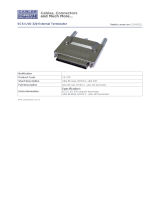
iv
CONTROLLING DATA COMPRESSION .........................................................................................................34
CARE OF DDS TAPE CARTRIDGES.............................................................................................................34
Handling DDS Tape Cartridges ..........................................................................................................34
Storing DDS Tape Cartridges .............................................................................................................35
BACKUP ROUTINES...................................................................................................................................35
Model 1: Daily Backup.......................................................................................................................35
Model 2: Weekly Rotation with Daily Backup .....................................................................................35
Model 3: Monthly and Weekly Rotation with Daily Backup.................................................................36
CLEANING TAPE HEADS............................................................................................................................37
ORDERING DDS TAPE CARTRIDGES..........................................................................................................38
DDS/MRS Logos.................................................................................................................................38
CHAPTER 4. TROUBLESHOOTING & DIAGNOSTICS.............................................................41
TROUBLESHOOTING OVERVIEW ................................................................................................................41
MODULE STATUS LIGHTS .........................................................................................................................42
TROUBLESHOOTING PROCEDURES.............................................................................................................45
SCSI Bus Troubleshooting Procedure..................................................................................................45
Fan Module Troubleshooting Procedure.............................................................................................47
Power Module Troubleshooting Procedures........................................................................................47
DDS Tape Module Troubleshooting Procedure...................................................................................49
Disk Module Troubleshooting Procedure............................................................................................49
MODULE REPLACEMENT PROCEDURES ......................................................................................................50
Fan Module Replacement Procedure ..................................................................................................50
Power Module Replacement Procedure...............................................................................................52
DDS Tape Module Replacement Procedure.........................................................................................53
Disk Module Replacement Procedures................................................................................................54
SE Disk Module Replacement Procedure (HP 3000 Series 900)..........................................................56
SE Disk Module Replacement Procedure (HP 9000 Series 700, C-Series, J-Series).............................56
SE Disk Module Replacement Procedure (HP 9000 Series 800)..........................................................56
DF Disk Module Replacement Requirements.......................................................................................58
DF Disk Module Replacement/Recovery Procedure (HP 3000 Series 900)..........................................60
DF Disk Module Replacement Procedure (HP 9000 Series 700, C-Series, J-Series)............................60
DF Disk Module Replacement Procedure (HP 9000 Series 800, No Strict Mirroring).........................61
DF Disk Module Replacement/Recovery Procedure for Attached Physical Volumes (HP 9000 Series
800 with Strict Mirroring)...................................................................................................................63
DF Disk Module Replacement/Recovery Procedure for Unattached Physical Volumes (HP 9000 Series
800 with Strict Mirroring)...................................................................................................................68
DF Disk Module - Is the Volume Group or Physical Volume Group Active? (HP 9000 Series 800 with
Strict Mirroring) .................................................................................................................................70
DF Disk Module - Is the Physical Volume Attached? (HP 9000 Series 800 with Strict Mirroring).......71
DIAGNOSTIC INFORMATION ......................................................................................................................71
Self-Test Diagnostics...........................................................................................................................71





















